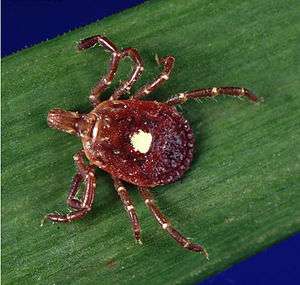Oribatida
| Oribatida | |
|---|---|
 | |
| Unidentified mite (Phthiracaridae) | |
| Scientific classification | |
| Kingdom: | Animalia |
| Phylum: | Arthropoda |
| Subphylum: | Chelicerata |
| Class: | Arachnida |
| Subclass: | Acari |
| Superorder: | Acariformes |
| Order: | Oribatida Dugès, 1833 |
| Suborders | |
| |
| Diversity | |
| c. 200 families, 1,200 genera, 6,600 species | |
| Synonyms | |
|
Cryptostigmata | |
Oribatida (formerly Cryptostigmata), also known as moss mites or beetle mites,[1] are an order of mites, in the "chewing Acariformes" clade Sarcoptiformes. They range in size from 0.2 to 1.4 millimetres (0.008 to 0.055 in).[1]
Oribatid mites generally have low metabolic rates, slow development and low fecundity.[1] Species are iteroparous with adults living a relatively long time; for example, estimates of development time from egg to adult vary from several months to two years in temperate forest soils.[1] Oribatid mites have six active instars: prelarva, larva, 3 nymphal instars and the adult.[1] All these stages after the prelarva feed on a wide variety of material including living and dead plant and fungal material, lichens and carrion; some are predatory, but none is parasitic and feeding habits may differ between immatures and adults of the same species.
The Oribatida are of economic importance as hosts of various tapeworm species, and by increasing the breakdown of organic material in the soil, in a similar manner to earthworms.[2]
Systematics
Oribatida is divided into the following taxa:[3]
- Palaeosomata Grandjean, 1969
- Acaronychoidea Grandjean, 1932 (6 genera)
- Acaronychidae Grandjean, 1932
- Palaeacaroidea Grandjean, 1932 (8 genera)
- Palaeacaridae Grandjean, 1932
- Parhyposomata Balogh & Mahunka, 1979
- Parhypochthonioidea Grandjean, 1969 (3 genera)
- Parhypochthoniidae Grandjean, 1969
- Gehypochthoniidae Strenzke, 1963
- Elliptochthoniidae Norton, 1975
- Enarthronota Grandjean, 1947
- Hypochthonoidea Berlese, 1910 (c. 8 genera)
- Hypochthoniidae Berlese, 1910
- Eniochthoniidae Grandjean, 1947
- Arborichthoniidae Balogh & Balogh, 1992
- Brachychthonoidea Thor, 1934 (c. 11 genera)
- Brachychthoniidae Thor, 1934
- Cosmochthonioidea Grandjean, 1947 (c. 14 genera)
- Cosmochthoniidae Grandjean, 1947
- Heterochthoniidae Grandjean, 1954
- Haplochthoniidae Hammen, 1959
- Pediculochelidae Lavoipierre, 1946
- Sphaerochthoniidae Grandjean, 1947
- Atopochthonioidea Grandjean, 1949 (3 genera)
- Atopochthoniidae Grandjean, 1949
- Pterochthoniidae Grandjean, 1950
- Phyllochthoniidae Travé, 1967
- Protoplophoroidea Ewing, 1917 (c. 7 genera)
- Protoplophoridae Ewing, 1917
- Mixonomata Grandjean, 1969
- Dichosomata Balogh & Mahunka, 1979
- Nehypochthonioidea Norton & Metz, 1980
- Nehypochthoniidae Norton & Metz, 1980
- Perlohmannioidea Grandjean, 1954
- Perlohmaniidae Grandjean, 1954
- Collohmanniidae Grandjean, 1958
- Eulohmannioidea Grandjean, 1931
- Eulohmanniidae Grandjean, 1931
- Epilohmannioidea Oudemans, 1923
- Epilohmanniidae Oudemans, 1923
- Lohmannioidea Berlese, 1916
- Lohmanniidae Berlese, 1916
- Euptyctima Grandjean, 1967
- Mesoplophoroidea Ewing, 1917
- Mesoplophoridae Ewing, 1917
- Euphthiracaroidea Jacot, 1930
- Oribotritiidae Grandjean, 1954
- Euphthiracaridae Jacot, 1930
- Synichotritiidae Walker, 1965
- Phthiracaroidea Perty, 1841
- Phthiracaridae Perty, 1841
- Steganacaridae Niedbała, 1986
- Holosomata Grandjean, 1969
- Crotonioidea Thorell, 1876
- Thrypochthoniidae Willmann, 1931
- Malaconothridae Berlese, 1916
- Nothridae Berlese, 1896
- Camisiidae Oudemans, 1900
- Crotoniidae Thorell, 1876
- Nanhermannioidea Sellnick, 1928
- Nanhermanniidae Sellnick, 1928
- Hermannioidea Sellnick, 1928
- Hermanniidae Sellnick, 1928
- Brachypylina Hull, 1918
- Pycnonoticae Grandjean, 1954
- Hermannielloidea Grandjean, 1934 (2 families)
- Neoliodoidea Sellnick, 1928 (1 family)
- Plateremaeoidea Trägårdh, 1926 (4 families)
- Gymnodamaeoidea Grandjean, 1954 (2 families)
- Damaeoidea Berlese, 1896 (1 family)
- Polypterozetoidea Grandjean, 1959 (2 families)
- Cepheoidea Berlese, 1896 (7 families)
- Charassobatoidea Grandjean, 1958 (3 families)
- Microzetoidea Grandjean, 1936 (1 family)
- Zetorchestoidea Michael, 1898 (1 family)
- Gustavioidea Oudemans, 1900 (8 families)
- Eremaeoidea Oudemans, 1900 (4 families)
- Amerobelboidea Grandjean, 1954 (10 families)
- Eremelloidea Balogh, 1961 (7 families)
- Oppioidea Sellnick, 1937 (12 families)
- Trizetoidea Ewing, 1917 (6 families)
- Otocepheoidea Balogh, 1961 (4 families)
- Carabodoidea Koch, 1837 (3 families)
- Tectocepheoidea Grandjean, 1954 (2 families)
- Hydrozetoidea Grandjean, 1954 (1 family)
- Ameronothroidea Willmann, 1931 (3 families)
- Cymbaeremaeoidea Sellnick, 1928 (3 families)
- Poronoticae Grandjean, 1954
- Licneremaeoidea Grandjean, 1931 (6 families)
- Phenopelopoidea Petrunkevitch, 1955 (1 family)
- Unduloribatoidea Kunst, 1971 (3 families)
- Limnozetoidea Thor, 1937 (2 families)
- Achipterioidea Thor, 1929 (2 families)
- Oribatelloidea Jacot, 1925 (3 families)
- Ceratozetoidea Jacot, 1925 (5 families)
- Zetomotrichoidea Grandjean, 1934 (1 family)
- Oripodoidea Jacot, 1925 (19 families)
- Galumnoidea Jacot, 1925 (3 families)
See also
References
- 1 2 3 4 5 Marjorie A. Hoy (2008). "Soil mites". In John L. Capinera. Encyclopedia of Entomology, Volume 1 (2nd ed.). Springer. pp. 3463–3466. ISBN 978-1-4020-6242-1.
- ↑ Edward W. Baker & G. W. Wharton (1952). "Oribatei Dugès, 1833". An Introduction to Acarology. New York: Macmillan. pp. 387–438.
- ↑ Luis S. Subías (2007). "Listado sistemático, sinonímico y biogeográfico de los ácaros oribátidos (Acariformes: Oribatida) del mundo (Excepto fósiles)" [Systematic and biogeographic list, with synonymies, of the oribatid mites (Acariformes: Oribatida) of the world (excluding fossils)] (PDF) (in Spanish). Retrieved January 5, 2008.
Further reading
| Wikimedia Commons has media related to Oribatida. |
- Krantz, G. W. (1978). A Manual of Acarology (2nd ed.). Corvallis, OR: Oregon State University. ISBN 978-0-88246-064-2.
- Halliday, R. B.; D. E. Walter; H. C. Proctor; R. A. Norton; M. J. Colloff, eds. (2001). Acarology, Proceedings of the 10th International Congress. Melbourne: CSIRO Publishing. pp. 1–960. ISBN 0-643-06658-6.
- Walter, D. E. & H. C. Proctor (2001). Mites in Soil, An interactive key to mites and other soil microarthropods. ABRS Identification Series. Collingwood, Victoria: CSIRO Publishing. ISBN 978-0-643-06790-5.
- Woolley, Tyler A. (1988). Acarology: Mites and Human Welfare. New York, NY: Wiley Interscience. ISBN 978-0-471-04168-9.
- Niedbala, Wojciech (1992). Phthiracaroidea (Acari, Oribatida): Systematic Studies. Warsaw, Poland: PWN + Elsevier. ISBN 978-8-301-09740-0.
